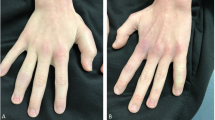Abstract
Purpose
Scurvy, due to vitamin C deficiency, is commonly referenced as a “forgotten” or “historical” disease. A growing number of case reports challenge this notion. Bone health providers are often consulted early in the presentation of scurvy to evaluate musculoskeletal complaints resulting from impaired collagen production and disrupted endochondral bone formation. In this report, we describe two cases of childhood scurvy. Our objective is to summarize the key features of scurvy for bone health providers, with the goal of raising awareness and facilitating diagnosis in future cases.
Case descriptions
Case one occurred in a 12-year-old non-verbal, non-ambulatory female on a ketogenic diet for refractory epilepsy. Clinical findings included hemarthrosis, transfusion dependent anemia, elevated inflammatory markers, and epiphysiolysis. Magnetic resonance imaging (MRI) revealed multi-focal bone marrow signal abnormalities and physeal irregularities. Case two occurred in a typically developing 5-year-old male presenting with limp and knee pain. Symptoms progressed despite casting and immobilization. Mild anemia, elevated inflammatory markers, and multi-focal marrow and physeal MRI abnormalities were identified. Subsequent dietary history revealed total absence of fruit or vegetable consumption. The diagnosis of scurvy was confirmed in both cases by undetectable plasma vitamin C concentrations. Treatment with vitamin C led to rapid clinical improvement.
Conclusion
Scurvy can no longer be considered a historical diagnosis and should not be forgotten when evaluating children with musculoskeletal ailments. Early recognition of the signs, symptoms, and imaging findings of scurvy can reduce the clinical burden of this disease with the timely initiation of vitamin C therapy.

Similar content being viewed by others
References
Aghajanian P, Hall S, Wongworawat MD, Mohan S (2015) The roles and mechanisms of actions of vitamin c in bone: new developments. J Bone Miner Res 30(11):1945–1955
Nishikimi M, Yagi K (1991) Molecular basis for the deficiency in humans of gulonolactone oxidase, a key enzyme for ascorbic acid biosynthesis. Am J Clin Nutr 54(6 Suppl):1203s–1208s
National institutes of health, office of dietary supplements. Vitamin c: Fact sheet for professionals. https://ods.od.nih.gov/factsheets/VitaminC-HealthProfessional/ Accessed 9/20/2019
Bingham AC, Kimura Y, Imundo L (2003) A 16-year-old boy with purpura and leg pain. J Pediatr 142(5):560–563
Brennan CM, Atkins KA, Druzgal CH, Gaskin CM (2012) Magnetic resonance imaging appearance of scurvy with gelatinous bone marrow transformation. Skelet Radiol 41(3):357–360
Duggan CP, Westra SJ, Rosenberg AE (2007) Case records of the Massachusetts general hospital. Case 23-2007. A 9-year-old boy with bone pain, rash, and gingival hypertrophy. N Engl J Med 357(4):392–400
Ma NS, Thompson C, Weston S (2016) Brief report: scurvy as a manifestation of food selectivity in children with autism. J Autism Dev Disord 46(4):1464–1470
Nastro A, Rosenwasser N, Daniels SP, Magnani J, Endo Y, Hampton E, Pan N, Kovanlikaya A (2019) Scurvy due to selective diet in a seemingly healthy 4-year-old boy. Pediatrics 144(3):e20182824
Swed-Tobia R, Haj A, Militianu D, Eshach O, Ravid S, Weiss R, Aviel YB (2019) Highly selective eating in autism spectrum disorder leading to scurvy: a series of three patients. Pediatr Neurol 94:61–63
Vaezipour N, Leibundgut K (2018) Nonalimental scurvy with relapse symptoms after stopping oral vitamin c supplementation. Pediatrics 142(2):e20172139
Baron JH (2009) Sailors' scurvy before and after james lind--a reassessment. Nutr Rev 67(6):315–332
Kinlin LM, Blanchard AC, Silver S, Morris SK (2018) Scurvy as a mimicker of osteomyelitis in a child with autism spectrum disorder. Int J Infect Dis 69:99–102
Gulko E, Collins LK, Murphy RC, Thornhill BA, Taragin BH (2015) Mri findings in pediatric patients with scurvy. Skelet Radiol 44(2):291–297
Weinstein M, Babyn P, Zlotkin S (2001) An orange a day keeps the doctor away: scurvy in the year 2000. Pediatrics 108(3):E55
Frank BS, Runciman M, Manning WA, Ivy DD, Abman SH, Howley L (2019) Pulmonary hypertension secondary to scurvy in a developmentally typical child. J Pediatr 208:291–291.e292
Bryant-Waugh R (2019) Avoidant/restrictive food intake disorder. Child Adolesc Psychiatr Clin N Am 28(4):557–565
Lipner S (2018) A classic case of scurvy. Lancet (London, England) 392(10145):431–431
Urueña-Palacio S, Ferreyro BL, Fernández-Otero LG, Calo PD (2018) Adult scurvy associated with psychiatric disorders and breast feeding. BMJ Case Rep. https://doi.org/10.1136/bcr-2017-223686 bcr2017223686
Levavasseur M, Becquart C, Pape E, Pigeyre M, Rousseaux J, Staumont-Sallé D, Delaporte E (2015) Severe scurvy: an underestimated disease. Eur J Clin Nutr 69(9):1076–1077
Joshi SM, Singh RK, Shellhaas RA (2013) Advanced treatments for childhood epilepsy: beyond antiseizure medications. JAMA Pediatr 167(1):76–83
Lennerz BS, Barton A, Bernstein RK et al (2018) Management of type 1 diabetes with a very low-carbohydrate diet. Pediatrics 141(6):e20173349
Willmott NS, Bryan RA (2008) Case report: scurvy in an epileptic child on a ketogenic diet with oral complications. Eur Arch Paediatr Dent 9(3):148–152
Ahmad SA, Al Thobiti TA, El Toum M, Al Harbi F (2018) Florid scurvy in an autistic child on a ketogenic diet. Pediatr Emerg Care https://doi.org/10.1097/PEC.0000000000001695 [published online ahead of print]
Hawthorne BE, Storvick CA (1948) Effect of sodium bicarbonate and ammonium chloride on ascorbic acid metabolism of adults. Proc Soc Exp Biol Med 67(4):447–449
Funding
This work was supported by the National Institutes of Health: K23DK114477 (DRW).
Author information
Authors and Affiliations
Corresponding author
Ethics declarations
Conflict of interest
None.
Additional information
Publisher’s note
Springer Nature remains neutral with regard to jurisdictional claims in published maps and institutional affiliations.
Electronic supplementary material
Fig. 2
Clinical approach to the patient with suspected scurvy. Clinical evaluation of patients with signs/symptoms of scurvy should include evaluation of dietary intake by a registered dietician, as well as imaging and biochemical evaluation as outlined above. Treatment with vitamin C supplementation can be initiated before biochemical confirmation of low vitamin C in cases where there is a high index of suspicion for scurvy. CRP, c-reactive protein; ESR, erythrocyte sedimentation rate; MRI, magnetic resonance imaging(PNG 791 kb)
ESM 1
(TIFF 109 kb)
ESM 2
(DOCX 13.5 kb)
Rights and permissions
About this article
Cite this article
Alten, E., Chaturvedi, A., Cullimore, M. et al. No longer a historical ailment: two cases of childhood scurvy with recommendations for bone health providers. Osteoporos Int 31, 1001–1005 (2020). https://doi.org/10.1007/s00198-019-05264-4
Received:
Accepted:
Published:
Issue Date:
DOI: https://doi.org/10.1007/s00198-019-05264-4




